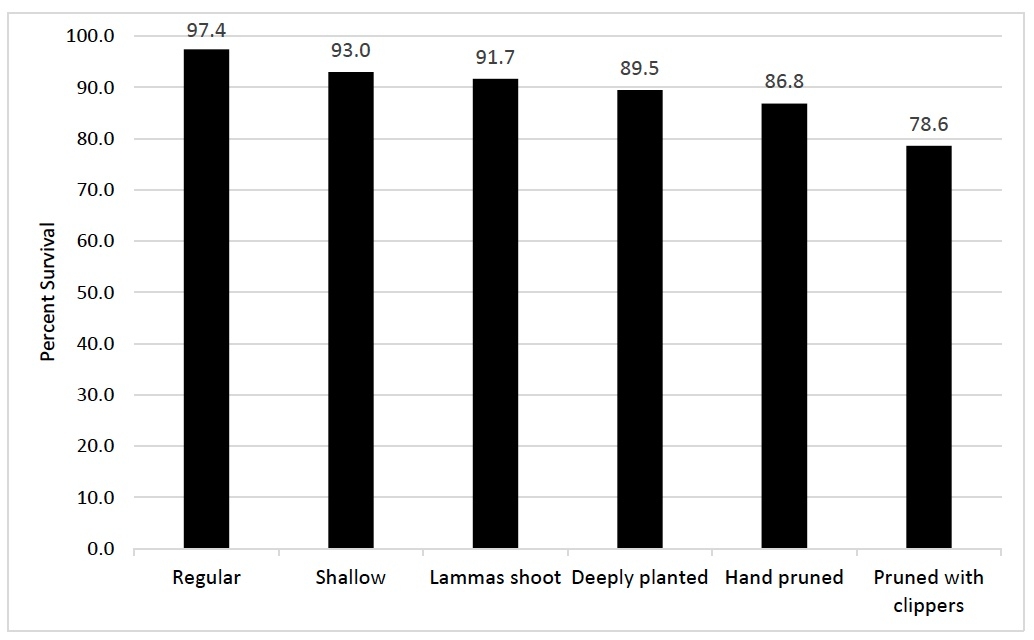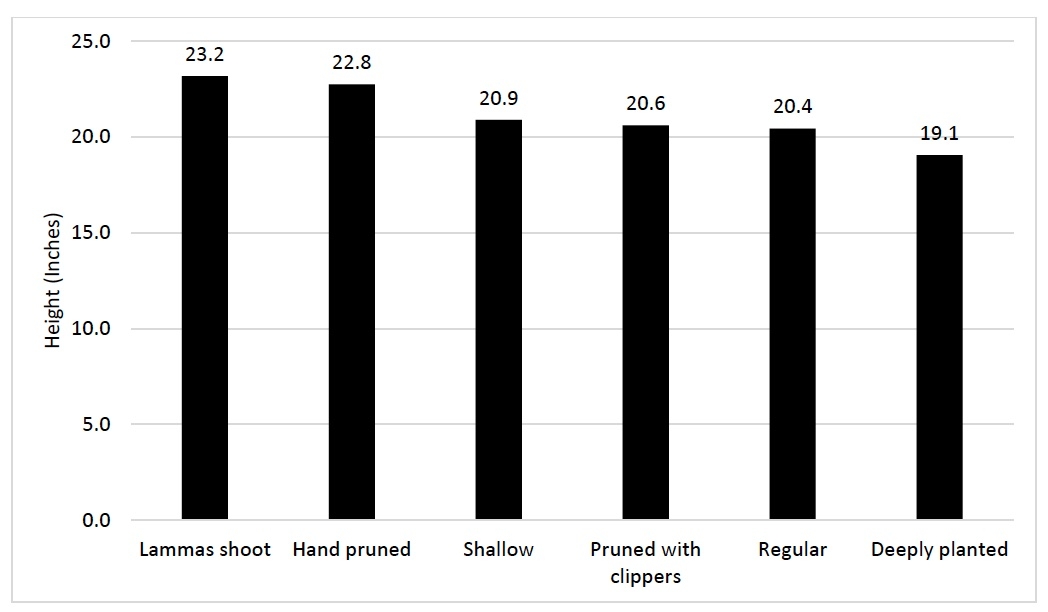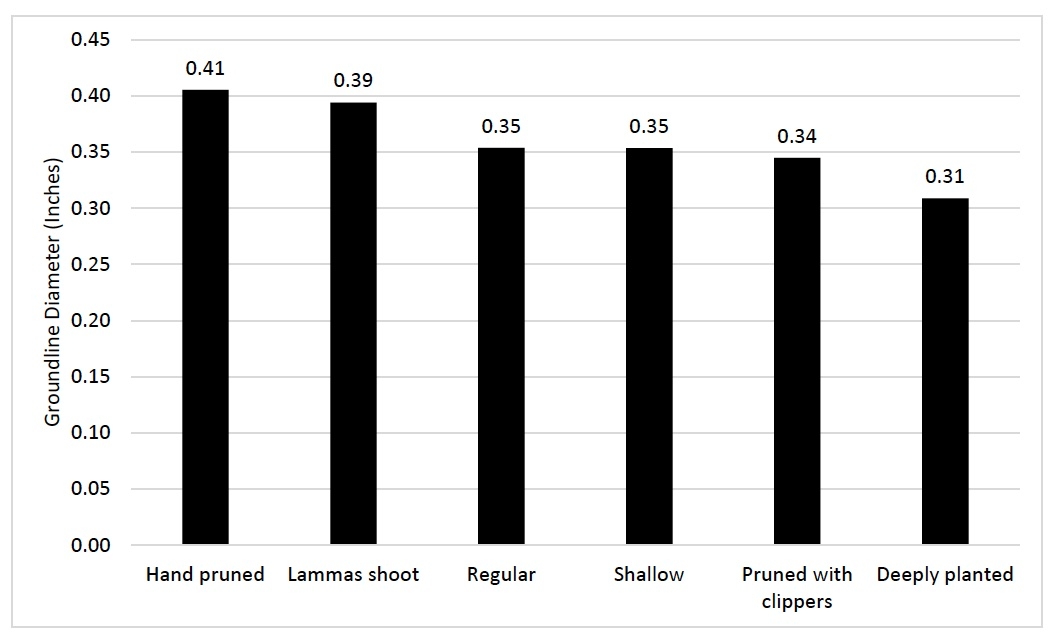Impact of Planting Treatments on Eastern White Pine Seedling Survival and Growth at the Matthews State Forest in Grayson County, Virginia
ID
CNRE-137NP
Introduction
The natural range of eastern white pine (Pinus strobus) extends along the east coast from northern Maine to northern Georgia. It has been an important tree in American history dating back to colonial times. In Virginia, pine forest types account for only 20% of the forests. However, they grow quickly and produce approximately 45% of the annual harvest volume (VDOF 2021). White pine is the third most common pine species in Virginia, with loblolly and Virginia pines being the most common species (Brandeis et al. 2018). Pine stands are important sources of revenue for landowners from timber sales. In some areas, landowners can also benefit from the sale of white pine greenery through “tipping” sales.
White pine seedlings are typically planted by hand in early spring. Planting crews are utilized to plant new stands after forest harvests but seedlings can also be planted in fields (VDOF 2017). Planting crews typically use hoedads or dibble bars for planting seedlings. The seedlings should be planted to the depth of the root collar (transition area between the stem and the roots). The most common spacing for planting pine is 10 x 10 feet or 436 seedlings per acre (VDOF 2017). This spacing provides the seedlings with an adequate amount of space to grow and mature. In areas where white pine weevil is not prevalent, white pine may be planted in full sunlight, but white pine is intermediate in shade tolerance and can also grow in the understory (VDOF 2017).
Survival of planted pine seedlings is critical for establishing productive plantations. Proper planting of seedlings is important for ensuring the best survival rate possible. When planting, there are several tree-planting errors that should be avoided to improve survival. Some of those errors include planting seedlings too deeply as well as planting them too shallow (VDOF 2017). Seedlings lifted from nursery beds may sometimes have a large root system that can make it difficult to properly and efficiently plant the seedlings. If root pruning is required to make planting easier, clippers are recommended instead of hand pruning. Seedlings at the nursery can also have an abnormal growth condition called lammas shoots. Lammas shoots are extra leader growth or whorls of branches that occur late in the growing season before they are lifted from the nursery beds (VDOF 2006). It was thought that this late season growth could reduce their survival when they are lifted from the beds and transplanted.
Methods
As part of an undergraduate research project, two Virginia Tech students collected data in a white pine seedling survival study to determine which planting treatments had the best survival and growth rates. The test plot was located on the Matthews State Forest in Grayson County, Virginia. The Bad Elf GPS app was used to determine the site's coordinates (36.627886°N, 80.949225°W) and elevation (2448 feet). A Suunto clinometer was used to determine average slope (10%) and a Silva ranger compass was used to find aspect (90°E). The soil type is Glenelg loam, which has high productivity for growing white pine (Web Soil Survey, 2021). A yardstick was used to measure seedling height, small calipers were used to collect the groundline diameter, and a 10-foot bamboo pole was used to assist in finding the location of the pine seedlings based on original planting spacing.
The white pine seedlings were grown by the Virginia Department of Forestry’s nursery in Augusta, Virginia, and relocated and planted as bareroot seedlings on the Matthews State Forest in early May of 2020. The data were collected in June and July 2021 which was during the second growing season following planting. The seedlings had two growing seasons in the nursery prior to planting on this site. Seedlings were planted approximately 10 feet apart in rows following the contour of the hillside (Figure 1). Each row consisted of a single treatment. There were two blocks of six treatments (12 rows total). A complete block of treatments was planted and then repeated further down the hillside (Figure 2).


The treatments included:
Regular – Seedlings were planted according to VDOF recommendations. A regular planting for eastern white pine is described as planting the seedling at the root collar (VDOF 2021).
Deep – Planting too deeply occurs when the root collar is below ground with soil covering part of the stem.
Shallow – Planting too shallow occurs when the root collar is above the soil line, potentially exposing some of the roots.
Hand pruned – Hand pruning is pulling off excess roots by hand before planting.
Pruned with clippers – Excess roots were trimmed with clippers prior to planting as recommended.
Lammas shoots – Seedlings that had lammas shoots prior to planting. A lammas shoot is an abnormal late season growth of lateral branches that occurs at the nursery due to weather conditions, nutrient availability and other various factors.
Results and Discussion
The most effective treatment for seedling survival was the regular treatment (97.4%), followed by shallow (93.0%), and then lammas shoot (91.7%) (Figure 3). Even though the regular treatment had the best survival rate, the lammas shoot (23.2 inches) and hand pruned (22.8 inches) treatments had greater average heights (Figure 4). In addition, these two treatments also had the largest average groundline diameters. Hand pruned seedlings had an average groundline diameter of 0.41 inches followed by the lammas shoot seedlings at 0.39 inches (Figure 5). The lammas shoot seedlings had slightly lower survival rates than regular or shallow planted seedlings, but those that survived showed the most height growth and second largest diameter. This is similar to previous studies that found that seedlings with lammas shoots tended to do well and did not generally cause reduced survival and growth (VDOF 2006).



Some of these results would be expected based on planting techniques for each treatment. For example, the deeply planted seedlings had a relatively good survival rate (89.5%), but were the shortest and smallest diameter of any of the treatments. This is likely because more of the seedling was placed underground at planting, reducing aboveground height. This case study also provided some unexpected results. For example, the survival rate and subsequent growth of the seedlings favored hand pruning over the generally recommended method of using clippers for root pruning.
In addition to being a relatively small case study, there were several other factors that could potentially impact results from this study. Seedlings were planted in May, which is later than the ideal planting time. Additionally, seedlings were planted in an open field predominantly covered by cool season grasses that competed with the seedlings. Competition could have been variable across the planting site, however.
Conclusions
As expected, regular planting remains the best treatment for white pine seedling survival. A substantial amount of research and field experience has gone into developing these standard planting protocols and it would be expected to result in the best survival rates. However, somewhat unexpectedly, the hand pruning treatment was more effective than pruning with clippers, and had an increase in survival rate of 8.3%. These results were somewhat unexpected because planting guidelines recommend pruning with clippers. This may be an area where further research would be warranted to determine if changes are needed to recommendations for the way planting crews and others handle extra roots prior to planting.
It should be noted that these results are from a single case study. As such, they do not apply to all situations and different results may be obtained from a replicated designed experiment. However, this case study shows that treatment of seedlings prior to planting can be an important factor in survival rates with a difference in survival rate of nearly 20% between the highest and lowest rates among treatments. An increase in survival rate of this magnitude can make a substantial difference in the value and productivity of the resulting stand.
However, it is also worth noting that even under less than ideal planting conditions and using intentionally mishandled seedlings, they were still resilient and all treatments had almost 80% or greater survival rates by the middle of their second growing seasons. While it is important to strive for the best possible planting quality, even under less than ideal conditions, it can still be possible to get an adequate survival rate for white pine seedlings.
References
Brandeis, Thomas J.; Hartsell, Andrew J.; Randolph, KaDonna C.; Oswalt, Christopher M. 2018.
Virginia’s Forests, 2016. Resour. Bull. SRS–223. Asheville, NC: U.S. Department of Agriculture Forest Service, Southern Research Station. 99 pp.
Virginia Department of Forestry (VDOF). 2021.
Pine Management. Available online at https://dof.virginia.gov/forest-management- health/learn-about-forest-management-health/pine-management/. Accessed 8/12/2021.
Virginia Department of Forestry (VDOF) Pine Planting Guide. 2017. Available online at https://dof.virginia.gov/wp-content/uploads/Pine-Planting-Guide_pub.pdf . Accessed 8/12/2021.
Virginia Department of Forestry (VDOF). 2006.
Forest Research Review August 2006. Charlottesville, VA. 6pp. Available online at https://dof.virginia.gov/wp-content/uploads/FRR-2006-08_pub.pdf. Accessed 11/11/2021.
Web Soil Survey. 2021. Soil Survey Staff, Natural Resources Conservation Service, United States Department of Agriculture. Web Soil Survey. Available online at http://websoilsurvey.sc.egov.usda.gov/. Accessed 8/12/2021.
Virginia Cooperative Extension materials are available for public use, reprint, or citation without further permission, provided the use includes credit to the author and to Virginia Cooperative Extension, Virginia Tech, and Virginia State University.
Virginia Cooperative Extension is a partnership of Virginia Tech, Virginia State University, the U.S. Department of Agriculture (USDA), and local governments, and is an equal opportunity employer. For the full non-discrimination statement, please visit ext.vt.edu/accessibility.
Publication Date
December 20, 2021



